|
|
 |
|
Cyclopoida ( Order ) |
|
|
|
Corycaeidae ( Family ) |
|
|
|
Corycaeus ( Genus ) |
|
|
|
Onychocorycaeus ( Sub-Genus ) |
|
|
| |
Corycaeus (Onychocorycaeus) giesbrechti F. Dahl, 1894 (F,M) | |
| | | | | | | Syn.: | Corycäus venustus : Giesbrecht, 1891; 1892 (p.659, 674, 772, figs.F,M);
Corycaeus venustus : Esterly, 1905 (p.225, figs.F, Rem.F,M); ? Carl, 1907 (p.18); A. Scott, 1909 (p.252); ? Wolfenden, 1911 (p.359); Wilson, 1932 (p.42); 1932 a (p.360, figs.F,M); ? Oliveira, 1945 (p.191); ? Turner & Dagg, 1983 (p.17, 22);
Corycaeus giesbrechti : Bainbridge, 1972 (p.61, Appendix Table I: vertical distribution vs. day/night, Table II: %, Table iV: thermal stability vs upwelling); Corral Estrada & Pereiro Muñoz, 1974 (tab.I); Avancini & al., 2006 (p.147, Pl. 115, figs.F,M, Rem.); Skovgaard & Salomonsen, 2009 (p.425, Table 2);
Onychocorycaeus giesbrechti : Gaudy, 1963 (p.33, Rem.); Boxshall & Halsey, 2004 (p.494); Miyashita & al., 2009 (p.815, Tabl.II); Vidjak & Bojanic, 2009 (p.434, Table II, IV, V); Vives & Shmeleva, 2010 (p.235, figs.F,M, Rem.); Isari & al., 2011 (p.51, Table 2, abundance vs distribution); Miyashita & al., 2012 (p.1557, Table 2: occurrence); Belmonte & al., 2013 (p.222, Table 2, abundance vs stations); Melo Jùnior & al., 2013 (p.363, Table 2, egg production); Dias & al., 2018 (p.1, Tables 2, 5: vertical distribution, abundance vs. season); Acha & al., 2020 (p.1, Table 3: occurrence % vs. ecoregions). | | | | Ref.: | | | F. Dahl, 1894 (p.72); M. Dahl, 1912 (p.88, figs.F,M); Sewell, 1924 (p.803); Farran, 1929 (p.211, 295); Rose, 1933 a (p.330, figs.F,M); Klevenhusen, 1933 (p.599, figs. Juv.M); 1933 a (p.88, carte 39); Rose, 1933 a (p.330, figs.F,M); Dakin & Colefax, 1933 (p.209); 1940 (p.113, figs.M); Wilson, 1942 a (p.181, fig.F); Krishnaswamy, 1953 (p.71, Rem.); Marques, 1958 a (p.146, figs.F,M, Rem.); Tanaka, 1960 (p.84, figs.F,M, Rem.); Fagetti, 1962 (p.52); Tanaka, 1964 (p.16); Cervigon, 1964 (p.184, figs.F,M); Corral Estrada, 1970 (p.245, figs.F); Björnberg, 1972 (p.96, figs.N); Razouls, 1972 (p.96, Annexe: p.132, figs.F); Marques, 1973 (p.248, fig.F); Chen & al., 1974 (p.62, figs.F); Razouls, 1974 c (1975) (p.89, figs.F); Dawson & Knatz, 1980 (p.10, figs.F,M); Björnberg & al., 1981 (p.676, F,M); Campaner, 1985 (p.12, figs.F,M, Rem.); Sazhina, 1985 (p.94, figs.N); Lakkis & Zeidane, 1987 (p.20, figs.F,M, Rem.); Chihara & Murano, 1997 (p.965, Pl.216, 217: F,M); Boxshall, 1998 (p.224); Bradford-Grieve & al., 1999 (p.888, 975, figs.F,M); Suarez-Morales & Leon-Oropeza, 1999 (p.706, figs.M); Fuentes-Reinés & Suarez-Morales, 2017 (p.519, figs.M, Rem.) | 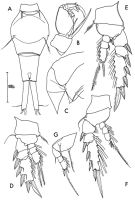 issued from : C. Razouls in Vie Milieu, 1974, 24 (1.A). [p.106, Fig.8]. Female (from W Medit.: Banyuls, France): A, 5th thoracic segment and urosome (dorsal); B, A2; C, last thoracic segments (dorsal, left side); D, P1; E, P2; F, P3; G, P4.
|
 issued from : A.F. Campaner in Bolm Inst. oceanogr., S. Paulo, 1985, 33 (1). [p.13, Fig.9]. Female (off Rio de Janeiro): a-b, habitus (dorsal, from 2 specimens in different aspects of the retraction of pedigerous somites); c, forehead (lateral); d, last three prosomal and 1st urosomal somites; d1 last prosomal somite (lateral, enlarged); e, terminal portion of last urosomal somite and caudal rami (dorsal); f, A2; g, P1; h, P2; i, P3; j, P4; K, P5.
|
 issued from : A.F. Campaner in Bolm Inst. oceanogr., S. Paulo, 1985, 33 (1). [p.14, Fig.10]. Male: a, habitus (dorsal); b; forehead (lateral); c, urosomal somite 1 (lateral left side); d, P5; d, A2.
|
 issued from : J. Corral Estrada in Tesis Doct., Univ. Madrid, A-129, Sec. Biologicas, 1970. [Lam.62]. Female from Canarias Is.: 1, habitus (dorsal); 2, idem (lateral left side); 3, A2; 4, exopodal segments of P1; 5, endopodal segments of P1; 6, P4.
|
 issued from : Q.-c Chen & S.-z. Zhang & C.-s. Zhu in Studia Marina Sinica, 1974, 9. [Pl.20, Figs.14-17]. Female (fom China Seas): 14, habitus (dorsal); 15, urosome (lateral right side); 16, A2; 17, P4.
|
 Issued from : W. Giesbrecht in Systematik und Faunistik der Pelagischen Copepoden des Golfes von Neapel und der angrenzenden Meeres-Abschnitte. – Fauna Flora Golf. Neapel, 1892. Atlas von 54 Tafeln. [Taf.51, Figs.32, 34]. As Corycäus venustus. Female: 32, urosome (dorsal); 34, habitus (dorsal).
|
 Issued from : W. Giesbrecht in Systematik und Faunistik der Pelagischen Copepoden des Golfes von Neapel und der angrenzenden Meeres-Abschnitte. – Fauna Flora Golf. Neapel, 1892. Atlas von 54 Tafeln. [Taf.51, Fig.33]. As Corycäus venustusMale: 33, habitus (dorsal).
|
 Issued from : W. Giesbrecht in Systematik und Faunistik der Pelagischen Copepoden des Golfes von Neapel und der angrenzenden Meeres-Abschnitte. – Fauna Flora Golf. Neapel, 1892. Atlas von 54 Tafeln. [Taf.51, Fig.47]. As Corycäus venustus. Female: 47, P4.
|
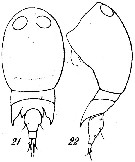 issued from : M. Dahl in Ergebnisse der Plankton-Expedition der Humboldt-Stiftung. Bd II, G. f1. I. Die Corycaeinen 1912. [Taf.XII, Figs.1, 2]. Female: 1, habitus (dorsal); 2, idem (lateral right side).
|
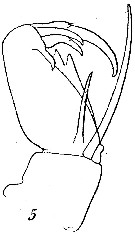 issued from : M. Dahl in Ergebnisse der Plankton-Expedition der Humboldt-Stiftung. Bd II, G. f1. I. Die Corycaeinen 1912. [Taf.XII, Fig.5]. Female: 5, A2.
|
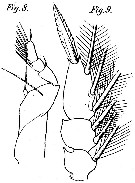 issued from : M. Dahl in Ergebnisse der Plankton-Expedition der Humboldt-Stiftung. Bd II, G. f1. I. Die Corycaeinen 1912. [Taf.XII, Figs.8, 9]. Female: 8, P4; 9, endopod of P2.
|
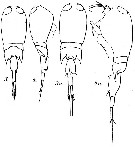 issued from : M. Dahl in Ergebnisse der Plankton-Expedition der Humboldt-Stiftung. Bd II, G. f1. I. Die Corycaeinen 1912. [Taf.XII, Figs.3, 3a, 4, 4a]. Male: 3, habitus (dorsal); 4, idem (lateral right side); 3a, habitus (dorsal; Pacific form); 4 a, lateral (left side; Pacific form).
|
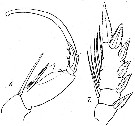 issued from : M. Dahl in Ergebnisse der Plankton-Expedition der Humboldt-Stiftung. Bd II, G. f1. I. Die Corycaeinen 1912. [Taf.XII, Figs.6, 7]. Male: 6, A2; 7, P1.
|
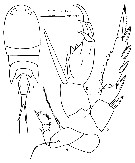 issued from : F. Cervigon iin Mem. Soc. Cienc. nat. La Salle, 1964, 24 (68). [p.185, Lam.15]. As Onychocorycaeus giesbrechti. Female (from Venezuela): 1, habitus (dorsal); 2,A2; 3, exopod of P2; 4, P4. Nota: Lengths ratio genital , anal segments and caudal rami 47:22:31; 48:23:29 and 48:19:32.
|
 issued from : F. Cervigon iin Mem. Soc. Cienc. nat. La Salle, 1964, 24 (68). [p.186, Lam.16]. As Onychocorycaeus giesbrechti. Male: 1, habitus (dorsal); 2, abdomen (lateral, left side); 4, P4.
|
 Issued from : O. Tanaka in Spec. Publs. Seto mar. biol. Lab., 10, 1960 [Pl. XXXVI, 6-10]. Female (from 27°37'S, 47°06'E): 6, habitus (dorsal); 7, abdomen (lateral); 8, A2. Nota : Cephalothorax and abdomen in the proportional lengths 64 to 36. Abdominal segments and caudal rami in the proportional lengths 47 : 23 : 30 = 100. Genital segment elongate ovate, 1.5 times as long as broad, and 1.5 times as long as high. Anal segment wider at the proximal than at the distal end, and 2 times as long as it is broad at the posterior border (18 : 9). Caudal rami about 7 times as long as broad (49 : 7). The present female specimen differs from C. giesbrechti described by M. Dahl in the proportional lengths of the abdominal segments and caudal rami (46 : 26 : 28) and in the more robust genital segment. Male (from 35°09'S, 20°13'E): 9, last thoracic segments and abdomen (dorsal); 10, same (lateral). Nota : Cephalothorax and abdomen in the proportional lengths 60 to 40. Abdominal segments and caudal rami in the proportional lengths 40 : 27 : 33 = 100. Genital segment elongate ovate, about 2 times as long as broad; ventral surface with a median hook; cylindrical part 1/1.6 the length of the posterior border of the segment. Anal segment with paralell lateral margins, 2.5 times as long as it is broad at the anterior border (19 : 7.5). Caudal rami 10 times as long as broad (25 : 2.5). Remarks: the male closely resembles C. agilis; the shape of the 4th thoracic segment which is more produced is the present specimen, the slender genital segment with a small ventral hook, and the large cylindrical part are the characters which distinguish the specimen from the male of C. agilis
|
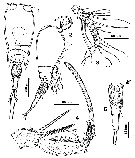 Issued from : E. Suarez-Morales & A. Leon-Oropeza in Crustaceana, 1999, 72 (7). [p.707, Figs.1-5]. Male (from 18°59.676'N, 92°43.188'W): 1-2, habitus (dorsal and lateral, respectively); 3, A1; 4, A2; 5, urosome (lateral).
|
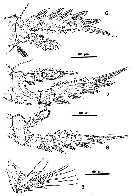 Issued from : E. Suarez-Morales & A. Leon-Oropeza in Crustaceana, 1999, 72 (7). [p.708, Figs.6-9]. Male: 6, right P1 (anterior); 7, left P2 (anterior); 8, left P3 (anterior); 9, left P4 (anterior).
|
 Issued from : J.M. Fuentes-Reinés & E. Suarez-Morales in Check List, 2017, 13 (5). [p.521, Figs. 25-28]. Male (from Rodadero Bay, N Colombia): 25, habitus (dorsal); 26, same (lateral, proximo-ventral spiniform process arrowed); 27, urosome (ventral); 28, P4.
| | | | | Compl. Ref.: | | | C.B. Wilson, 1950 (p.194); Deevey, 1960 (p.5, Table II, annual abundance) ; Ganapati & Shanthakumari, 1962 (p.10, 16); V.N. Greze, 1963 a (tabl.2); Shmeleva, 1963 (p.141); Duran, 1963 (p.26); Björnberg, 1963 (p.82, Rem.); De Decker & Mombeck, 1964 (p.12); Neto & Paiva, 1966 (p.33, Table III, annual cycle); Furuhashi, 1966 a (p.295, vertical distribution in Kuroshio region, Table 9); Mazza, 1966 (p.74); Pavlova, 1966 (p.45); Ehrhardt, 1967 (p.744, geographic distribution, Rem.); Séguin, 1968 (p.488); Dowidar & El-Maghraby, 1970 (p.268); Deevey, 1971 (p.224); Apostolopoulou, 1972 (p.329, 387, fig.13); Binet & al., 1972 (p.73); Vives & al., 1975 (tab.II, IV); Boxshall, 1977 b (p.555); Dessier, 1979 (p.184, 202, 208); Vaissière & Séguin, 1980 (p.23, tab.2); Herman & Sameoto, 1981 (p.228, Table 1, 2, abundance); Kovalev & Shmeleva, 1982 (p.86); Scotto di Carlo, 1984 (p.1042); Sazhina, 1985 a (p.491, tab.3); Regner, 1985 (p.11, Rem.: p.43); Moraitou-Apostolopoulou, 1985 (p.303, occurrence/abundance in E Mediterranean Sea, Rem.: p.314); Diouf & Diallo, 1987 (p.260); Lozano Soldevilla & al., 1988 (p.61); Lopes, 1994 (tab.1); Shih & Young, 1995 (p.76); Go & al., 1997 (tab.1); Hure & Krsinic, 1998 (p.94, 105); Hopcroft & al., 1998 (tab.2); Lopes & al., 1998 (p.195, tab.2); Lopes & al., 1999 (p.215, tab.1); Neumann-Leitao & al., 1999 (p.153, tab.2); Siokou-Frangou, 1999 (p.479); Suarez-Morales & Leon-Oropeza, 1999 (p.705, Rem.); Seridji & Hafferssas, 2000 (tab.1); Vukanic, 2003 (p.139, tab.1); Lan & al., 2004 (p.332, tab.1); Lo & al.*, 2004 (p.218, fig.6); Lo & al., 2004 (p.89, tab.1); Dias & Bonecker, 2005 (p.100 + poster); Isari & al., 2006 (p.241, tab.II); Sterza & Fernades, 2006 (p.95, Table 1, occurrence); Dias & Araujo, 2006 (p.80, Rem., chart); Zervoudaki & al., 2006 (p.149, Table I); Khelifi-Touhami & al., 2007 (p.327, Table 1); Neumann-Leitao & al., 2008 (p.799: Tab.II, fig.6); Brugnano & al., 2010 (p.312, Table 2, 3); Dias & al., 2010 (p.230, Table 1); Mazzocchi & Di Capua, 2010 (p.428); Medellin-Mora & Navas S., 2010 (p.265, Tab. 2); Hsiao S.H. & al., 2011 (p.475, Appendix I); Hsiao & al., 2011 (p.317, Table 2, indicator of seasonal change); Magris & al., 2011 (p.260, abundance, interannual variability); Tutasi & al., 2011 (p.791, Table 2, abundance distribution vs La Niña event); Uysal & Shmeleva, 2012 (p.909, Table I); Salah S. & al., 2012 (p.155, Tableau 1); in CalCOFI regional list (MDO, Nov. 2013; M. Ohman, comm. pers.); Lidvanov & al., 2013 (p.290, Table 2, % composition); Bonecker & a., 2014 (p.445, Table II: frequency, horizontal & vertical distributions); Pansera & al., 2014 (p.221, Table 2, abundance); Zaafa & al., 2014 (p.67, Table I, occurrence); Marquez-Rojas & al., 2014 (p.9, Rem., %); Dias & al., 2015 (p.483, Table 2, abundance, biomass, production, Table 4: % vs. season); Araujo & al., 2016 (p.1, Table 3, abundance, %); Benedetti & al., 2016 (p.159, Table I, fig.1, functional characters); Ben Ltaief & al., 2017 (p.1, Table III, Summer relative abundance) | | | | NZ: | 15 + 1 doubtful | | |
|
Distribution map of Corycaeus (Onychocorycaeus) giesbrechti by geographical zones
|
| | | | | | | | | | | | | Loc: | | | South Africa (E), Angola, Baia Farta, Congo, ? N St. Helena Is., G. of Guinea, off Lagos, Ivorian shelf, Casamance, off S Cape Verde Is., Canary Is., Morocco-Mauritania, Cap Ghir, Brazil (S, Paranagua Bay, Ubatuba, Rio de Janeiro, Campos Basin, Sao Joao, Vitoria Bay, Vitoria-Cabo de Sao Tomé, off Macaé, Mucuri estuary, Guarau estuary, Camamu, off Natal), Venezuela, Campeche Bay, Jamaica, Caribbean Colombia (Rodadero Bay, Guajira, Tayrona), Venezuela (Cariaco Gulf), G. of Mexico, Florida, off Bermuda, Delaware Bay (outside), Chesapeake Bay, ? Long Island, off Woods Hole, Bay of Biscay, Ibero-moroccan Bay, Medit. (M'Diq, Alboran Sza, Gulf of Annaba, Castellon, G. of Lion, Marseille, Ligurian Sea, Tyrrhenian Sea, Lake Faro, Messine, Gulf of Taranto, Taranto Harbour, NW Tunisia, G. of Gabes, Malta, Adriatic Sea, Ionian Sea, Aegean Sea, Thracian Sea, Lebanon Basin, Alexandria), Suez Canal, Red Sea, Madagascar (Nosy Bé), Indian, India (Lawson's Bay, Chilka Lake), ? Ambon Bay (from Carl, 1907), ,China Seas ( East China Sea, South China Sea), Taiwan Strait, Taiwan (E, SW, NW, N: Mienhua Canyon), Okinawa, Japan, Australia (New South Wales), Pacif. (central & SE), California (San Pedro Bay), Galapagos-Ecuador, Peru (at 9°S), off Chile | | | | N: | 124 | | | | Lg.: | | | (35) [Atlant. N] F: 0,95-0,88; M: 0,87-0,82; [Atlant. trop.] F: 1,02-0,93; (46) F: 0,9-0,85; M: 0,76; (66) F: 1,05; M: 0,9-0,84; (104) M: 0,8; (109) F: 0,85-0,82; (114) F: 1,04-0,97; (142) F: 1-0,8; M: < 0,8; (180) F: 1-0,91; M: 0,83-0,81; (237) F: 1.0; M: 0.8-1.1; (336) F: 1-0,9; (531) F: 1,3; M: 0,95; (618) F: 0,9; M: 0,94; (666) F: 0,95-0,9; M: 0,9-0,77; (668) F: 1,03-0,96; M: 0,8-0,77; (670) F: 0,99-0,86; M: 0,81-0,79; (671) F: 1,04-0,93; M: 0,88-0,82; (864) F: 1,0; (920) F: 0,91; (1175) M: ±1,1; (1313) M: 0,742; {F: 0,80-1,30; M: 0,742-1,10} | | | | Rem.: | Epipelagic- mesopelagic.
It is probable that most of the authors having cited C. venustus Dana (synonym of C. crassiusculus) have referred to the form of Giesbrecht (1892) which is a synonym of C. giesbrechti.
After Björnberg (1963, P.82) this species is uually present in Brazilian waters and may occur in dominant or subdominant numbers in shelf and coastal waters.
For Fuentes-Reinés & E. Suarez-Morales (2017, p.519 ), this Colombian form can be easily distinguished from its congeners by: 1- the presence of small medium-sized hook on the anterior surface of genital somite; 2- dorsal margin of genital somite straight; 3- anal somite as long as caudal rami; 4- P4 with 2 unequally long basipodal setae.
For Boxshall & Halsey (2004, p.491) the subgenus (Dahl, 1912) is considered as full generic status pending phylogenetic revision of the whole family at the generic level | | | Last update : 04/12/2020 | |
|
|
 Any use of this site for a publication will be mentioned with the following reference : Any use of this site for a publication will be mentioned with the following reference :
Razouls C., Desreumaux N., Kouwenberg J. and de Bovée F., 2005-2024. - Biodiversity of Marine Planktonic Copepods (morphology, geographical distribution and biological data). Sorbonne University, CNRS. Available at http://copepodes.obs-banyuls.fr/en [Accessed April 26, 2024] © copyright 2005-2024 Sorbonne University, CNRS
|
|
 |
 |






















